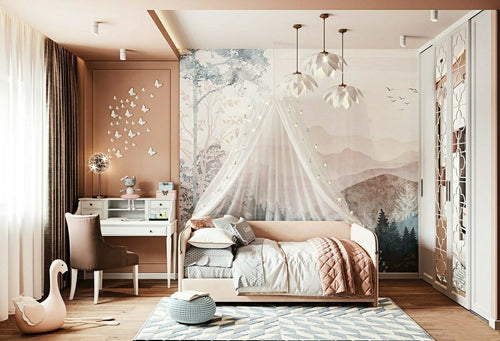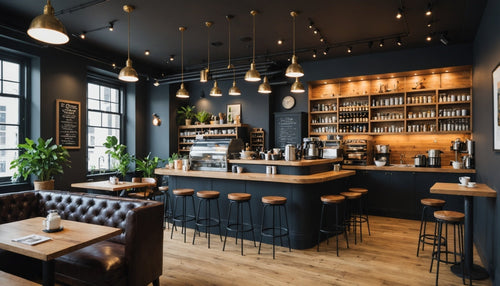When designing a room, one of the most important yet often overlooked elements is lighting. Colour temperature plays a crucial role in determining the atmosphere of a space, influencing not just the visibility but also the emotional impact a room can have. Whether you want a warm, inviting feel for a living room or a bright, energizing environment for your home office, understanding how colour temperature affects room aesthetics is key to creating the perfect ambience.
Let’s dive into how colour temperature works and how you can use it to enhance your room’s design.
1. What is Colour Temperature?
Colour temperature refers to the warmth or coolness of a light source, typically measured in Kelvins (K). Lights with lower Kelvin ratings (around 2700K–3000K) emit a warm, yellowish glow, while those with higher Kelvin ratings (5000K–6500K) produce a cooler, bluish light. The right colour temperature can dramatically affect the mood and functionality of a room, making it an essential element in your home décor.
2. How Colour Temperature Affects Room Aesthetics
a) Warm Lighting (2700K–3000K)
Warm lighting is often associated with a relaxing, inviting atmosphere. It’s perfect for living rooms, bedrooms, and dining areas, where you want to create a cosy, intimate vibe. The golden glow of warm lighting complements neutral tones, wood finishes, and soft textures, making it ideal for spaces where relaxation is key. It helps to highlight earthy tones and creates a peaceful, comfortable environment.
- Best for: Living rooms, bedrooms, dining rooms, and lounges.
- Creates: A welcoming, calm, and intimate atmosphere.
b) Neutral Lighting (3500K–4100K)
Neutral lighting offers a balance between warmth and coolness, providing a natural, white light that works well in spaces where functionality is important. It’s often used in kitchens, bathrooms, and workspaces as it helps reduce eye strain and ensures that colours are rendered more accurately. This lighting also works well in modern interiors with sleek, contemporary furnishings.
- Best for: Kitchens, bathrooms, workspaces, and entryways.
- Creates: A clean, neutral, and versatile atmosphere.
c) Cool Lighting (5000K–6500K)
Cool lighting is perfect for high-energy spaces that require focus and concentration. Its bluish tone mimics daylight and is often used in home offices, study areas, and bathrooms. This lighting is ideal for environments where clarity and precision are important, such as reading or doing intricate tasks. Cool lighting also works well in minimalist or industrial-themed rooms with white or grey tones.
- Best for: Home offices, study rooms, bathrooms, and laundry rooms.
- Creates: A bright, energizing, and focused atmosphere.
3. Choosing the Right Colour Temperature for Your Room
The key to selecting the ideal colour temperature is understanding how the room will be used and the mood you want to create. Here’s a guide to help you pick the right lighting for each room:
- Living Room: Opt for warm lighting to create a cosy and inviting space where you can relax and entertain. Soft, warm lighting can also highlight artwork, furniture, and décor.
- Bedroom: A warm, soft light is perfect for bedrooms, where a relaxed and restful environment is key. Consider dimmable options to adjust the lighting depending on your activities, whether reading or unwinding before bed.
- Kitchen: Neutral lighting works best in the kitchen, where bright, clear visibility is needed for cooking. Choose lighting that enhances the colour of your kitchenware and countertops without being too harsh.
- Bathroom: Neutral to cool lighting is ideal for bathrooms, where you’ll need bright, clear light for grooming and applying makeup. Avoid very warm lighting as it can distort colours, making tasks like shaving or applying makeup more difficult.
- Home Office: Cool lighting helps improve focus and concentration. It’s especially effective for home offices where tasks require sharp attention and accurate colours, such as reading or working on a computer.
4. Layering Lighting for Depth and Interest
To truly elevate your room’s aesthetics, consider layering your lighting. Combining different colour temperatures can create depth and enhance the overall mood of the space. For instance, a living room can benefit from a combination of warm ambient lighting with cool task lighting near reading or work areas. By using a mix of light sources—overhead lights, floor lamps, table lamps, and accent lighting—you can create dynamic, multi-dimensional spaces that feel balanced and well-lit.
5. Choosing Light Bulbs and Fixtures
When selecting light bulbs for your home, consider the colour temperature on the packaging, as many bulbs now come in a range of temperatures. You can also opt for adjustable or smart lighting solutions, allowing you to change the colour temperature to suit the time of day or your mood.
For a more stylish touch, explore decorative light fixtures that complement your room's aesthetic while providing the right colour temperature. For example, pendant lights or track lighting can add both visual interest and functional lighting to your space.
Wrapping Up
Colour temperature is a powerful tool for shaping the atmosphere and aesthetics of any room in your home. Whether you’re looking to create a calming environment with warm lighting or a productive space with cool lighting, understanding how to use colour temperature to your advantage will help you design spaces that perfectly match your lifestyle. At Orangme, we offer a variety of lighting options that can help you achieve the perfect ambience for every room in your home. Explore our collection and start transforming your space today!


















































